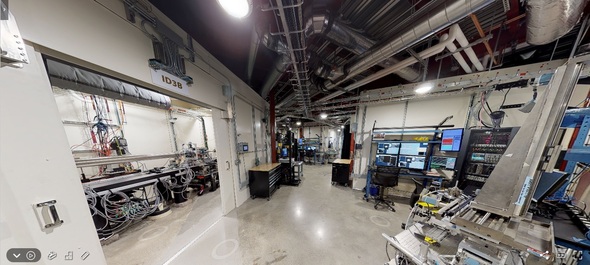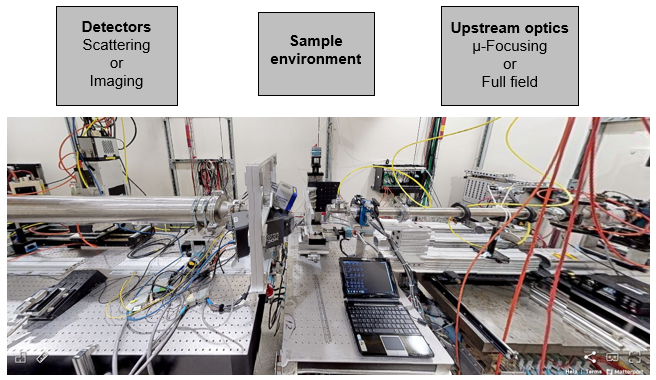
Welcome to the Functional Materials Beamline (FMB) at MSN-C
The Functional Materials Beamline at CHESS, located at hutch ID3B, provides synchrotron-based X-ray scattering and imaging techniques optimized for the study of manufacturing processes and properties of modern structural and functional materials. FMB delivers X-rays at four discrete energies ranging from 9.7 keV to 22 keV, making it especially suitable for the study of lower-density materials such as polymers and polymer-composites. Areas of interest include 3D printing of polymer composites and thin films. Detailed information about FMB's optical configuration and user science may be found here. FMB's partner beamline, the Structural Materials Beamline (SMB), was built to operate at higher energies (40-200 keV) and focuses on higher density materials, especially metals.FMB User Guide & Cheat Sheet
FMB Documentation - Staff
Beamline Description
FMB is fed by synchrotron radiation from a 1.5 m Chess Compact Undulator (CCU), which is then directed at a novel, custom-designed side-bounce monochromator system, consisting of four separate diamond single crystals. These crystals are prealigned to the (111), (220), (311), and (400) Bragg Peaks, with the result that each crystal selects a different energy at a fixed diffraction angle of 36°: 9.73, 15.9, 18.65, and 22.5 keV, respectively.| Diamond mono | Energy (keV) | Beam mode | Flux at 100 mA (ph/s) | Special properties |
|---|---|---|---|---|
| 111 | 9.7 | Bulk | 1-3 × 1012 | Unfocused: 1 mm vertical × 2 mm horizontal / Mirror-focused: 45 μm verical × 2 mm horizontal |
| 111 | 9.8 | Microbeam | 4 × 1010 | 2 µm vertical x 15 µm horiztonal |
| 220 | 15.9 | Bulk | 1 × 1013 | Large beam available for full field imaging (≥2x2 mm2 ) |
| 311 | 18.6 | Bulk | (not recorded) | Large beam available for full field imaging (≥2x2 mm2 ) |
| 400 | 22.5 | Bulk | 5 × 1012 | Large beam available for full field imaging (≥2x2 mm2 ) |
- The Upstream Flightpath (right) houses slits and ion chambers, and can switch between a Compound-Refractive-Lens (CRL) based setup for focused beam applications such as scan-probe SAXS/WAXS, and a standard setup with collimating and guard slits for bulk SAXS/WAXS or full-field imaging.
- Sample Environments (middle): a flexible area that can be altered to accomdate various samples, sample degrees of freedom, and/or sample environments. FMB has hosted a wide range of in-situ user experiments, including:
- Linkam heating and tensile stages
- Diamond anvil cell
- 3D printer with commercial heated print head and custom, CHESS-designed heated copper bed
- User-built systems including autonomous solution mixing, rheology capillaries, microfluidic pumps, and in-situ laser annealing
- Downstream (left): Where the detectors are placed. Can be adjusted based on what is desired from the X-rays, defined by the experiment: Full-field, Small Angle X-ray Scattering (SAXS), Wide Angle X-ray Scattering (WAXS)

Data collection modes
| Mode | Availability | Access |
|---|---|---|
| Bulk SAXS/WAXS | Yes For dynamic experiments |
Preferred in-person |
| Microprobe SAXS/WAXS | Yes | Remote or in-person |
| GISAXS/GIWAXS | In development | n/a |
| Full-field imaging | Yes Radiography (movies) Tomography is not standard |
Preferred in-person |
SAXS q range
At 9.7 keV:| Sample-to-detector distance (mm) | Beam location on detector | Mode | q range (Å-1) |
|---|---|---|---|
| ~420 | Bottom | Bulk GISAXS/GIWAXS | in-plane: 0.01 to ~0.47; out-of-plane: up to ~1.04 |
| ~1100 | Center | Microprobe SAXS/WAXS | ~0.005 to ~0.23 |
| ~2200 | Center | Bulk SAXS/WAXS | ~0.004 to ~0.12 |
- Full-Field images are collected in parallel, i.e. using a 2D detector placed downstream of the sample, and with a beam that simultaneously illuminates the whole field of view of an image. Such methods include traditional X-ray Radiography and phase-contrast imaging (PCI).
- In contrast to full-field techniques, Scan-Probe images are created by sweeping a sample in 2D through a small or focused X-ray beam. In this case, the size of the X-ray beam determines the spatial resolution of the sample. FMB offers spatially resolved SAXS/WAXS in a scan-probe mode.
Other modes
FMB can also collect bulk or micro-beam scattering (SAXS/WAXS) data during in-situ sample treatment (e.g. heating, stretching, compression). FMB does not typically award beamtime for single/bulk SAXS/WAXS or radiography snapshots that could be accomplished with a lab source. GISAXS and GIWAXS are increasingly supported at FMB.Access
FMB is supported by the Air Force Research Lab, and beamtime allocaation prioritizes projects of interest to AFRL, the Department of Defense, and their Original Equipment Manufacturers. Academic users can be awarded beamtime if they are affiliated with or funded by any of these groups, or if their research is of interest to AFRL and their partners. Please contact FMB-affiliated scientific staff Peter Ko, Kirt Page, Louisa Smieska, or MSN-C director Arthur Woll before submitting a proposal or beam time request to FMB. Proposals are submitted through CHESS BeamPASS.Remote and in-person operations
Please see the current CHESS user guide for the most up to date information on CHESS' operating status: https://www.chess.cornell.edu/user-guide Most FMB experiments are conducted in person. Remote operation is offered for ex-situ SAXS/WAXS conducted in microprobe or bulk beam modes.- For users running experiments remotely: Remote Access to FMB Station Computer
Web Utilities
- WebTopicList - all topics in alphabetical order
- WebChanges - recent topic changes in this web
- WebNotify - subscribe to an e-mail alert sent when topics change
- WebRss, WebAtom - RSS and ATOM news feeds of topic changes
- WebPreferences - preferences of this web
| I | Attachment | Action | Size | Date | Who | Comment |
|---|---|---|---|---|---|---|
| |
FMB_Beamline.png | manage | 450 K | 30 Jun 2020 - 14:15 | UnknownUser | |
| |
MSN-C-3D.jpg | manage | 71 K | 03 Jul 2020 - 12:14 | ArthurWoll | |
| |
MSN-C-VR-FMB.jpg | manage | 379 K | 03 Jul 2020 - 14:33 | ArthurWoll | |
| |
ScanTimeEstimator.xlsx | manage | 9 K | 23 Feb 2022 - 15:27 | LouisaSmieska |
 Copyright © by the contributing authors. All material on this collaboration platform is the property of the contributing authors.
Copyright © by the contributing authors. All material on this collaboration platform is the property of the contributing authors. Ideas, requests, problems regarding CLASSE Wiki? Send feedback

